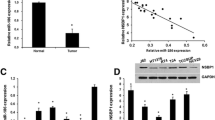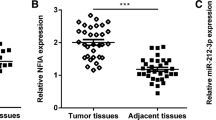Abstract
Bladder cancer has been identified as one of the most malignant cancers with high incidence and mortality. The underlying mechanisms by which regulate the tumorigenesis of bladder cancer deserve further investigation. Here, we found that miR-192-5p was downregulated in human bladder cancer cell lines and tissues. Overexpression of miR-192-5p significantly inhibited the growth of bladder cancer cells, while depletion of miR-192-5p exerted opposite effect. Bioinformatics analysis and molecular mechanism study identified that miR-192-5p targeted the transcription factor Yin Yang 1 (YY1) and decreased the expression level of YY1. Highly expressed YY1 attenuated the potential tumor suppressive function of miR-192-5p. The expression of miR-192-5p was negatively correlated with that of YY1 in bladder cancer tissues. These results indicated that miR-192-5p might serve as a promising target in bladder cancer diagnosis and therapy.





Similar content being viewed by others
References
Gordetsky J, Collingwood R, Lai WS, Del Carmen Rodriquez Pena M, Rais-Bahrami S. Second opinion expert pathology review in bladder cancer: implications for patient care. Int J Surg Pathol. 2017;26:12–7. https://doi.org/10.1177/1066896917730903.
Katafigiotis I, Sfoungaristos S, Martini A, Stravodimos K, Anastasiou I, Mykoniatis I, et al. Bladder cancer to patients younger than 30 years: a retrospective study and review of the literature. Urologia. 2017;84:231–5. https://doi.org/10.5301/uj.5000264.
Kutwin P, Konecki T, Cichocki M, Falkowski P, Jablonowski Z. Photodynamic diagnosis and narrow-band imaging in the management of bladder cancer: a review. Photomed Laser Surg. 2017;35(9):459–64. https://doi.org/10.1089/pho.2016.4217.
Tang X, Du P, Yang Y. The clinical use of neutrophil-to-lymphocyte ratio in bladder cancer patients: a systematic review and meta-analysis. Int J Clin Oncol. 2017. https://doi.org/10.1007/s10147-017-1171-5.
Kaufman DS, Shipley WU, Feldman AS. Bladder cancer. Lancet. 2009;374(9685):239–49. https://doi.org/10.1016/S0140-6736(09)60491-8.
Cilek EE, Ozturk H, Gur Dedeoglu B. Construction of miRNA-miRNA networks revealing the complexity of miRNA-mediated mechanisms in trastuzumab treated breast cancer cell lines. PLoS One. 2017;12(10):e0185558. https://doi.org/10.1371/journal.pone.0185558.
Lee S, Jiang X. Modeling miRNA-mRNA interactions that cause phenotypic abnormality in breast cancer patients. PLoS One. 2017;12(8):e0182666. https://doi.org/10.1371/journal.pone.0182666.
Pradhan AK, Emdad L, Das SK, Sarkar D, Fisher PB. The enigma of miRNA regulation in cancer. Adv Cancer Res. 2017;135:25–52. https://doi.org/10.1016/bs.acr.2017.06.001.
Wang K, Chen M, Wu W. Analysis of microRNA (miRNA) expression profiles reveals 11 key biomarkers associated with non-small cell lung cancer. World J Surg Oncol. 2017;15(1):175. https://doi.org/10.1186/s12957-017-1244-y.
Yang F, Ning Z, Ma L, Liu W, Shao C, Shu Y, et al. Exosomal miRNAs and miRNA dysregulation in cancer-associated fibroblasts. Mol Cancer. 2017;16(1):148. https://doi.org/10.1186/s12943-017-0718-4.
Yu Y, Nangia-Makker P, Farhana L, Majumdar APN. A novel mechanism of lncRNA and miRNA interaction: cCAT2 regulates miR-145 expression by suppressing its maturation process in colon cancer cells. Mol Cancer. 2017;16(1):155. https://doi.org/10.1186/s12943-017-0725-5.
Blanca A, Cheng L, Montironi R, Moch H, Massari F, Fiorentino M, et al. Mirna expression in bladder cancer and their potential role in clinical practice. Curr Drug Metab. 2017. https://doi.org/10.2174/1389200218666170518164507.
Braicu OL, Budisan L, Buiga R, Jurj A, Achimas-Cadariu P, Pop LA, et al. miRNA expression profiling in formalin-fixed paraffin-embedded endometriosis and ovarian cancer samples. Onco Targets Ther. 2017;10:4225–38. https://doi.org/10.2147/OTT.S137107.
Chen Y, Min L, Ren C, Xu X, Yang J, Sun X, et al. miRNA-148a serves as a prognostic factor and suppresses migration and invasion through Wnt1 in non-small cell lung cancer. PLoS One. 2017;12(2):e0171751. https://doi.org/10.1371/journal.pone.0171751.
Chen Y, Yang X, Xu Y, Cao J, Chen L. Genomic analysis of drug resistant small cell lung cancer cell lines by combining mRNA and miRNA expression profiling. Oncol Lett. 2017;13(6):4077–84. https://doi.org/10.3892/ol.2017.5967.
Daniunaite K, Dubikaityte M, Gibas P, Bakavicius A, Rimantas Lazutka J, Ulys A, et al. Clinical significance of miRNA host gene promoter methylation in prostate cancer. Hum Mol Genet. 2017;26(13):2451–61. https://doi.org/10.1093/hmg/ddx138.
Eissa S, Habib H, Ali E, Kotb Y. Evaluation of urinary miRNA-96 as a potential biomarker for bladder cancer diagnosis. Med Oncol. 2015;32(1):413. https://doi.org/10.1007/s12032-014-0413-x.
Yang X, Shi L, Yi C, Yang Y, Chang L, Song D. MiR-210-3p inhibits the tumor growth and metastasis of bladder cancer via targeting fibroblast growth factor receptor-like 1. Am J Cancer Res. 2017;7(8):1738–53.
Shi HB, Yu JX, Yu JX, Feng Z, Zhang C, Li GY, et al. Diagnostic significance of microRNAs as novel biomarkers for bladder cancer: a meta-analysis of ten articles. World J Surg Oncol. 2017;15(1):147. https://doi.org/10.1186/s12957-017-1201-9.
Yan-Chun L, Hong-Mei Y, Zhi-Hong C, Qing H, Yan-Hong Z, Ji-Fang W. MicroRNA-192-5p promote the proliferation and metastasis of hepatocellular carcinoma cell by targeting SEMA3A. Appl Immunohistochem Mol Morphol. 2015. https://doi.org/10.1097/PAI.0000000000000296.
Zou YF, Wen D, Zhao Q, Shen PY, Shi H, Zhao Q, et al. Urinary MicroRNA-30c-5p and MicroRNA-192-5p as potential biomarkers of ischemia–reperfusion-induced kidney injury. Exp Biol Med. 2017;242(6):657–67. https://doi.org/10.1177/1535370216685005.
Zhang Y, Huang R, Zhou W, Zhao Q, Lu Z. miR-192-5p mediates hypoxia/reoxygenation-induced apoptosis in H9c2 cardiomyocytes via targeting of FABP3. J Biochem Mol Toxicol. 2017;31(4). https://doi.org/10.1002/jbt.21873.
Jin H, Qiao F, Wang Y, Xu Y, Shang Y. Curcumin inhibits cell proliferation and induces apoptosis of human non-small cell lung cancer cells through the upregulation of miR-192-5p and suppression of PI3K/Akt signaling pathway. Oncol Rep. 2015;34(5):2782–9. https://doi.org/10.3892/or.2015.4258.
Epstein JI, Amin MB, Reuter VR, Mostofi FK. The World Health Organization/International Society of Urological Pathology consensus classification of urothelial (transitional cell) neoplasms of the urinary bladder. Bladder Consensus Conference Committee. Am J Surg Pathol. 1998;22(12):1435–48.
Shuang Y, Li C, Zhou X, Huang Y, Zhang L. MicroRNA-195 inhibits growth and invasion of laryngeal carcinoma cells by directly targeting DCUN1D1. Oncol Rep. 2017;38(4):2155–65. https://doi.org/10.3892/or.2017.5875.
Han Q, Lin X, Zhang X, Jiang G, Zhang Y, Miao Y, et al. WWC3 regulates the Wnt and Hippo pathways via Dishevelled proteins and large tumour suppressor 1, to suppress lung cancer invasion and metastasis. J Pathol. 2017;242(4):435–47. https://doi.org/10.1002/path.4919.
Sun X, Zhang L. MicroRNA-143 suppresses oral squamous cell carcinoma cell growth, invasion and glucose metabolism through targeting hexokinase 2. Biosci Rep. 2017;37(3). https://doi.org/10.1042/bsr20160404.
Li W, Yang W, Liu Y, Chen S, Chin S, Qi X, et al. MicroRNA-378 enhances inhibitory effect of curcumin on glioblastoma. Oncotarget. 2017;8(43):73938–46. https://doi.org/10.18632/oncotarget.17881.
Liu W, Wang S, Zhou S, Yang F, Jiang W, Zhang Q, et al. A systems biology approach to identify microRNAs contributing to cisplatin resistance in human ovarian cancer cells. Mol BioSyst. 2017. https://doi.org/10.1039/c7mb00362e.
Aschenbrenner DS. Updated review confirms potential risk of bladder cancer with pioglitazone. Am J Nurs. 2017;117(4):25. https://doi.org/10.1097/01.NAJ.0000515230.35655.54.
Traboulsi SL, Brimo F, Yang Y, Maedler C, Prevost N, Tanguay S, et al. Pathology review impacts clinical management of patients with T1-T2 bladder cancer. Can Urol Assoc J. 2017;11(6):188–93. https://doi.org/10.5489/cuaj.4126.
Xie Y, Ma X, Chen L, Li H, Gu L, Gao Y, et al. MicroRNAs with prognostic significance in bladder cancer: a systematic review and meta-analysis. Sci Rep. 2017;7(1):5619. https://doi.org/10.1038/s41598-017-05801-3.
Ye M, Zhang J, Zhang J, Miao Q, Yao L, Zhang J. Curcumin promotes apoptosis by activating the p53-miR-192-5p/215-XIAP pathway in non-small cell lung cancer. Cancer Lett. 2015;357(1):196–205. https://doi.org/10.1016/j.canlet.2014.11.028.
Atchison M, Basu A, Zaprazna K, Papasani M. Mechanisms of Yin Yang 1 in oncogenesis: the importance of indirect effects. Crit Rev Oncog. 2011;16(3–4):143–61.
Zheng L, Chen Y, Ye L, Jiao W, Song H, Mei H, et al. miRNA-584-3p inhibits gastric cancer progression by repressing Yin Yang 1-facilitated MMP-14 expression. Sci Rep. 2017;7(1):8967. https://doi.org/10.1038/s41598-017-09271-5.
Author information
Authors and Affiliations
Corresponding author
Ethics declarations
Conflict of interest
The authors declare that they have no conflicts of interests.
Rights and permissions
About this article
Cite this article
Ji, D., Jiang, L. & Li, Y. MiR-192-5p suppresses the growth of bladder cancer cells via targeting Yin Yang 1. Human Cell 31, 210–219 (2018). https://doi.org/10.1007/s13577-018-0201-6
Received:
Accepted:
Published:
Issue Date:
DOI: https://doi.org/10.1007/s13577-018-0201-6




